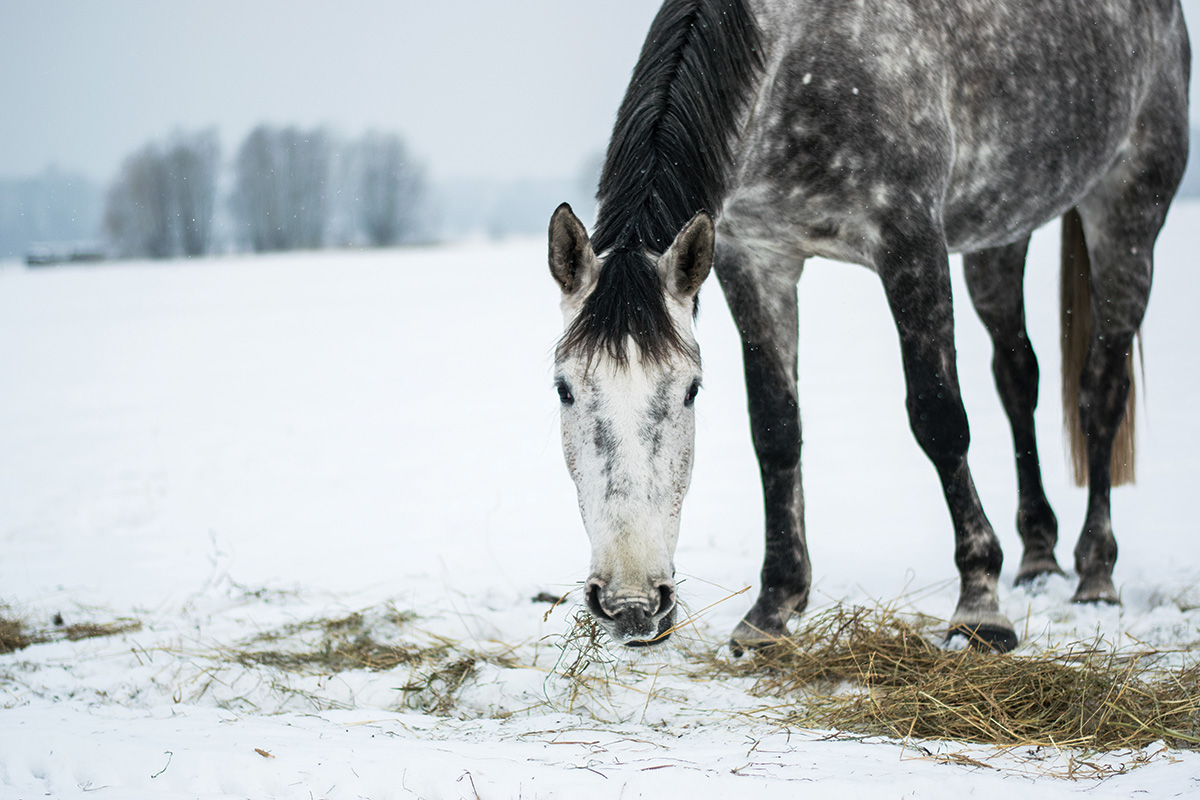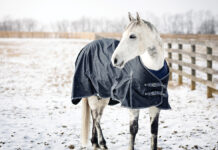
As temperatures drop, feeding your horse presents a new set of challenges. Instead of grazing all day on nutritious green grass, he’ll probably be switching to a diet of hay. Many horses lose weight without access to unlimited pasture. In addition, impaction colic due to dehydration presents a very real risk. Read on to stay ahead of these risks this winter.
Hay Keeps Your Horse Warm in the Winter
While round-bale hay presents a convenient method of feeding many horses for a long time in the winter, be picky about quality when buying it. Many are stored outdoors, which is OK for cattle use, but hay for horses must be stored under cover to avoid mold spores that cause respiratory disease and illness.
Additionally, cattle-quality hay is very stemmy and tends to be unpalatable and wasted through trampling. Shop around for round bales that resemble your small-bale hay quality. Using a bale feeder will help prevent much of the hay from being wasted.
Hay Alternatives
If you don’t have room to store hay for the entire winter and find yourself faced with a hay shortage, there are some alternatives available. Beet pulp, senior feed, hay cubes and hay pellets are all good ways to provide forage and stretch your hay supply. Keep in mind that none of these provide long-stem forage, so start using them to stretch your hay supply before you run out completely.
Vitamins & Minerals
Without access to green grass, horses may become deficient in vitamins A and E, which are the first to go after grass is baled into hay and stored for long periods. A ration balancer or vitamin/mineral supplement are options to consider for winter feeding if your horse isn’t fed a commercial equine grain mix, which is already fortified with vitamins and minerals.
Additionally, your horse should always have free access to salt. Since ice-cold salt blocks can become unappealing to lick, the best option is a feeder with loose salt. Horses tend to regulate their salt intake very well, and this also keeps them drinking plenty of water.
Hydration Nation
The most important nutrient in your horse’s diet is water. Without staying properly hydrated, the contents of the intestines can dry out as they pass through, causing impaction colic. Although this is often the easiest type to resolve with a vet’s assistance, every horse owner would prefer to steer clear of a case of colic.
If your temperatures regularly fall below freezing, check water troughs at least twice a day, breaking up any surface ice. Better yet, use insulated buckets or float a trough heater in the water. Although horses will drink very cold water, they will drink more if it is in the 40 to 65-degree Fahrenheit range.
Be extra-careful about trough heater cords, making sure they’re wrapped in wire or conduit so mice and horses can’t nibble on them. Stick your hand in daily to check for any wayward electric current, which will stop horses from drinking immediately.
Winter Weight Maintenance for Your Horse
Many horses shed pounds in the winter as they burn more calories to maintain their core temperature. Be prepared for this and have extra hay and grain on hand if you need to increase rations.
You may also consider switching to alfalfa hay or supplementing your grass hay with it (as opposed to adding more grain). Alfalfa boosts the calories per pound of hay, while still ensuring enough forage is in the diet.
If you are prepared for the challenges of feeding your horse in the winter, you won’t be taken by surprise when Mother Nature throws you a curveball this season.
This article about feeding your horse in winter appeared in the November/December 2022 issue of Horse Illustrated magazine. Click here to subscribe!





